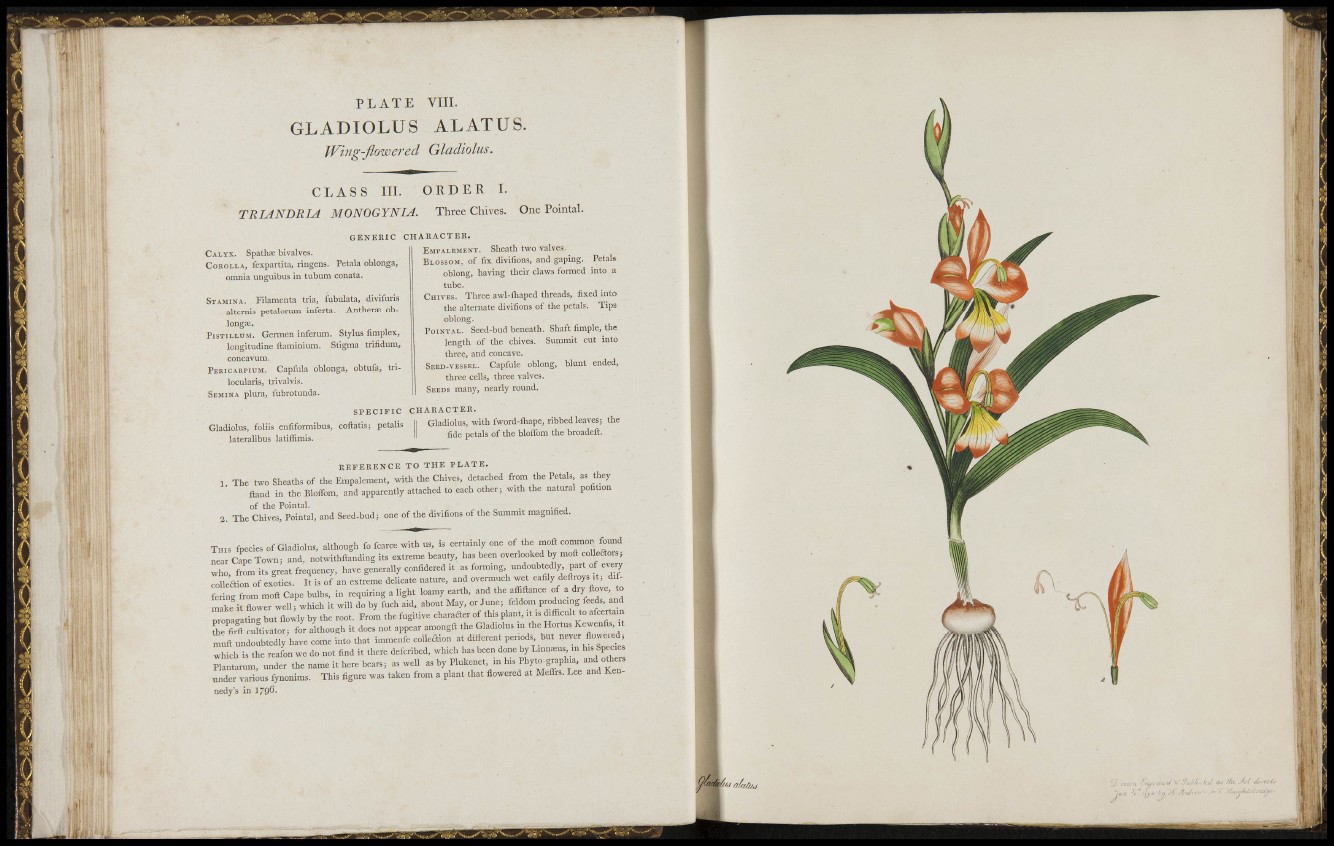
( i Sai
P L A T E VIII.
GLADIOLUS ALATUS.
Wing-flowered Gladiolus.
C L A S S in. ORDER L
TRIJNDRIA MONOGYNIA. Three Chives. One Pointal.
G E N E R I C CHARACTER.
C A L Y X . Spatha; bivalves.
C O R O L L A , fexpartita, ringens. Pétala oblonga,
omnia unguibus in tubum conata.
S T A M I N A . Filamenta tria, fubulata, divifuris
alternis petalorum inferta. Antherae oblonga;,
PisTiLLOM. Germen inferum. Stylus fimplex,
longitudine ñamínium. Stigma trifidum,
conca vum.
P E R I C A K P I U M . Capfula oblonga, obtufa, trilocularis,
trivalvis.
S E M I N A plura, fubrotunda.
S P E C I F I C
Gladiolus, foliis enfiformibus, coftatis; petalis
lateralibus latiffimis.
E M P A L E M E N T . Sheath two valves.
B L O S S O M , of fix divifions, and gaping. Petals
oblong, having their claws formed into a
tube.
C H I V E S . Three awl-lliaped threads, fixed into
the alternate divifions of the petals. Tips
oblong.
P O I N T A L . Seed-bud beneath. Shaft fimple, the
length of the chives. Summit cut into
three, and concave.
S E E D - V E S S E L . Capfule oblong, blunt ended,
three cells, three valves.
SEEDS many, nearly round.
C H A R A C T E R .
Gladiolus, with fword-fliape, ribbed leaves; the
fide petals of the bloflbm the broadeft.
R E F E R E N C E TO THE PLATE.
1 The two Sheaths of the Empalement, witlr the Chives, detached from the Petals as they
ftand in the BlolTom, and apparently attached to each other; with the natural pofition
of the Pointal. . ,
2. The Chives, Pointal, and Seed-bud; one of the divifions of the Summit magnified.
T H I S fpecies of Gladiolus, although fo fcarce with us, is certainly one of the moft common found
near Cape Town; and, not.vithftanding its extreme beauty, has been overlooked by moft colleaor
who, f r l its great frequency, have generally confidered it as forming undoubtedly part of eveiy
r J e i t i o n of exotics. It is of an extreme delicate nature, and overmuch wet eafily deftroys it; diff
S ^ g from moft Cape bulbs, in requiring a light loamy earth, and the affiftance of a dry ftove, to
l a k e it flower well; which it will do by fuch aid, about May, or June; feldom producing feeds, and
Z ^ ^ i X L llo;iy by the root. From the fugitive charader of this plant, it is ^fficult to afcertain
tl e firft ultivator; for akhough it does not appear amongft the Gladiolus in the Hortus Ivewenfis, it
muft undoubtedly have come into that ioimenfe colleaion at different periods but never flowered;
which is the reafon we do not find it there defcribed, which has been done by Linnaeus in hi^
Plantarum, under the name it here bears; as well as by Plukenet, in his Phyto^graplna, and others
under various fynonims. This figure was taken from a plant that flowered at Meffrs. Lee and Kennedy's
in 1796.
: ili
hfi
i
li
¡.'-"¡M i!I •;t li
ìli
' afa/M
y«« bp A' Ân/itu-J .jv.i iUyU'tndf